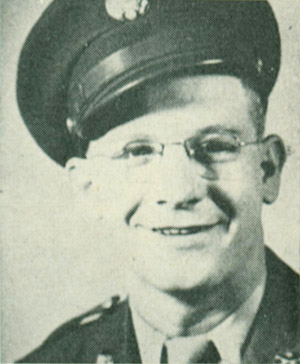

Remember...
Lee Peter Cordent
1923-1944
"Your task will not be an easy one. Your enemy is well-trained, well equipped and battle-hardened. He will fight savagely."
General Dwight D. Eisenhower, 6 June 1944
Pete Lee Cordent, per his birth certificate, was born to Peter Paul and Laura Daisy McVicker Cordent of Cascade in Preston County, West Virginia, on September 11, 1923. Mr. Cordent was from Poland. Mrs. Cordent, who was known by her middle name, Daisy, was from Tunnelton, West Virginia.
According to the 1930 U.S. Federal Census, the family was living in the Valley Magistrate District in Preston County. Mr. and Mrs. Cordent were parents of Marie and Peter, who was known as Lee, and in fact later records show him to be Lee Peter Cordent. His father was a coal miner, and his mother did not work outside of the home.
In 1940, the census taker found only Mr. and Mrs. Cordent and Lee still living together, but by then, in Monongalia County. Mr. Cordent was a laborer in a limestone mine. Daughter Marie was no longer living with them, but was with her husband, John Pringle, in Monongalia County. Lee Cordent was listed as a new worker.
Lee Cordent attended Waitman Barbe School, which was an elementary and junior high school on River Road, outside of Morgantown. Lee Cordent entered the service on May 19, 1943, and left the Christopher Coal Company. U.S. Army World War II Enlistment Records, 1938-1946, state that he was separated, but with dependents, and he listed as next of kin his sister, Marie.
Lee Cordent was then stationed in Fort McClellan, Alabama, a member of the 12th Regiment, 4th Infantry Division. The division shipped out to England, landing there in January 1944.
The work of the 4th Infantry Division during World War II is quite well documented in books and on websites. The 4th landed on Utah Beach on D-Day, June 6, 1944. ("WWII," Regimental History, accessed 28 June 2017, http://www.212warriors.com/ww_II.html.) No record could be found that established with certainty that Pvt. Cordent was there, but he was assigned to the 12th Regiment, 4th Infantry Division; thus, it is reasonable to assume that their history is his history. A summary of their work may help us understand Pvt. Cordent's experiences during the war.
According to Regimental History's account of D-Day, Utah Beach was the first of the two American landing zones established because it was a deep-water harbor. Its location would be the stage for the planned quick capture of Cherbourg. On D-Day, the 4th landed 1,700 vehicles and over 23,000 American soldiers on Utah Beach. By the end of the day, 197 were killed and 60 were missing. Given the accomplishment, this loss was taken as slight and the beach relatively easy to take. But not evenly so. While most of the Division reached its goals, two regiments did not. The 12th was one of them.
According to Kenneth Slawenski, the Germans had flooded a two-mile-wide area of marshland and then trained their firepower on the only avenue out. The 12th "was forced to wade through waist-high water under constant threat from enemy guns. It took three hours to cross the marsh." After this, J. D. Salinger, who had been serving with HQ counterintelligence, met up with the unit. He'd come ashore 10 hours earlier.
Regimental History's account continues:
After wading through the inundated area, the 12th Infantry came up on the left of the 502d Parachute Infantry south of Beuzeville- au-Plain, and remained there for the night. The 1st and 2d Battalions, 22d Infantry, which also had to wade inland through the swamps and spend about seven hours in the marsh, reached dry land in the vicinity of St. Martin-de-Varreville and moved on to St. Germain-de-Varreville, where they bivouacked for the night.
The regiment consisted of 3,080 men on June 6, but would number only 1,130 by July 1. Pvt. Cordent would have been among the living at that time.
Between June 6 and July 1, the 12th proved itself a bold and aggressive unit. The regiment ignored its open flanks and pushed ahead on D-Day plus 3. On D-Day plus 4, the 12th and the 8th continued to take advantage of their momentum. They reached their objectives southwest and northeast of Montebourg, where they paused to defend the ground they had so rapidly gained.
When it was time to move again, together with the 8th, the 12th set up a trap for enemy forces attempting to escape. Regimental History states: "During this time, the 8th and 12th, in brilliant maneuvers and violent battles polished off enemy positions southeast of the city." The 12th advanced to the coast by June 25, the end of the Cherbourg campaign.
What followed was a fierce battle with the goal of breaking through German forces south of Carentan. This meant clearing rugged terrain, swamps, and hedgerows, where the enemy was hidden, and the operation lasted for 10 days, with the 4th ultimately attaining its objectives. Fighting near P riers lasted from July 6th through the 12th. ("4th Infantry Division [United States]," Wikipedia, accessed 28 June 2017, https://en.wikipedia.org/wiki/4th_Infantry_Division_(United_States)#World_War_II.)
It was on July 6th that Pvt. Cordent was killed.
The 4th went on without their many fallen comrades in arms, fought to liberate Paris, and fought in the Battle of the Bulge. For valor shown during the Battle of the Bulge at Luxembourg, the unit was awarded the Presidential Unit Citation.
Article prepared by Cynthia Mullens
June 2017

West Virginia Archives and History welcomes any additional information that can be provided about these veterans, including photographs, family names, letters and other relevant personal history.